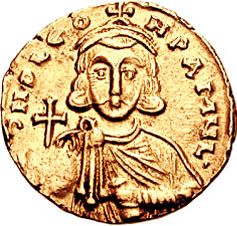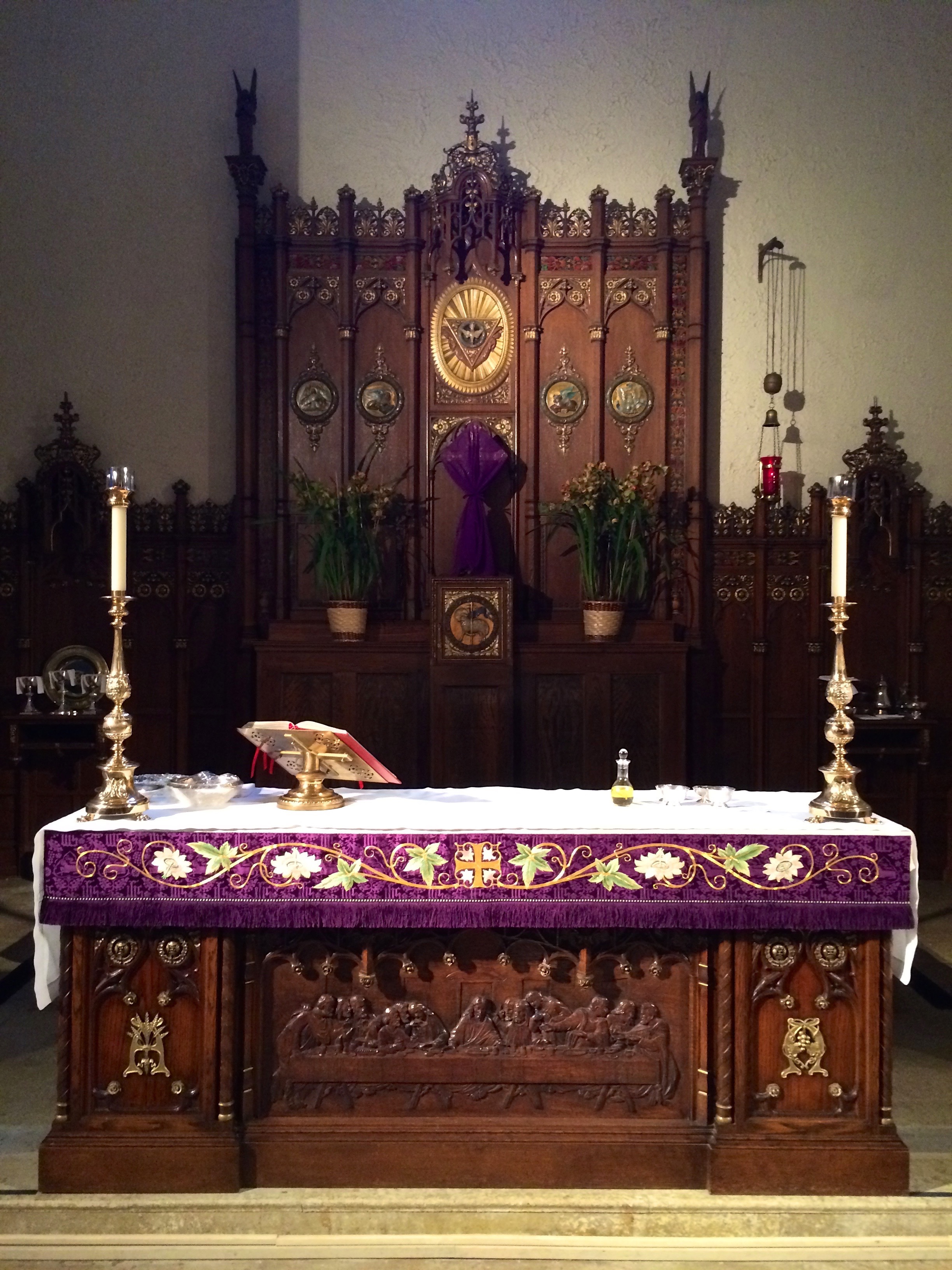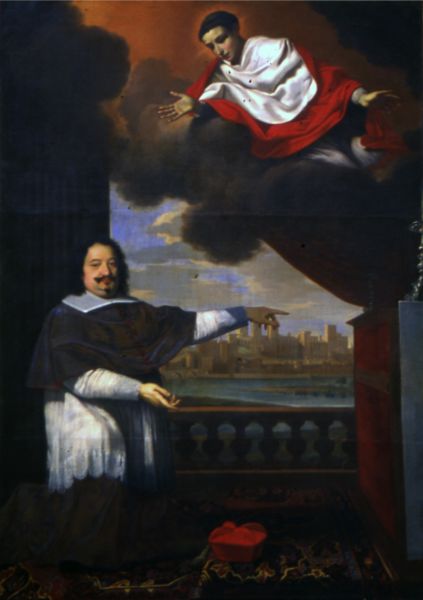|
San Giorgio In Velabro
San Giorgio in Velabro is a Catholic church dedicated to St. George on Via del Velabro in the historic center of Rome in the Velabrum and the Ripa district. The church—the result of the 9th century expansion of a previous diaconal building and subsequent remodeling—stands near the Arch of Janus in the small square of the Cloaca Maxima. The location of S. Giorgio is not far from the place where the founding legend of Rome places the discovery of the twins Romulus and Remus by the she-wolf. The façade of the church encroaches upon and incorporates the Arcus Argentariorum, which was completed in 204 AD. S. Giorgo falls within the territory of the parish of Santa Maria in Portico in Campitelli and is a rectory entrusted to the Canons Regular of the Order of the Holy Cross as well as a titular church, whose cardinal-deacons over the years have included Pope Boniface IX and Pope Martin V, as well as Pierre de Luxembourg ( pseudocardinal of the Antipope Clement VII) and ... [...More Info...] [...Related Items...] OR: [Wikipedia] [Google] [Baidu] |
Rome
Rome (Italian language, Italian and , ) is the capital city and most populated (municipality) of Italy. It is also the administrative centre of the Lazio Regions of Italy, region and of the Metropolitan City of Rome. A special named with 2,746,984 residents in , Rome is the list of cities in the European Union by population within city limits, third most populous city in the European Union by population within city limits. The Metropolitan City of Rome Capital, with a population of 4,223,885 residents, is the most populous metropolitan cities of Italy, metropolitan city in Italy. Rome metropolitan area, Its metropolitan area is the third-most populous within Italy. Rome is located in the central-western portion of the Italian Peninsula, within Lazio (Latium), along the shores of the Tiber Valley. Vatican City (the smallest country in the world and headquarters of the worldwide Catholic Church under the governance of the Holy See) is an independent country inside the city boun ... [...More Info...] [...Related Items...] OR: [Wikipedia] [Google] [Baidu] |
Founding Of Rome
The founding of Rome was a prehistoric event or process later greatly embellished by Roman historians and poets. Archaeological evidence indicates that Rome developed from the gradual union of several hillfort, hilltop villages during the Prehistoric Italy#Bronze Age, Final Bronze Age or early Iron Age Europe#Italy, Iron Age. Prehistoric Italy, Prehistoric habitation of the Italian Peninsula occurred by 48,000 Before Present, years ago, with the area of Rome being settled by around 1600 BC. Some evidence on the Capitoline Hill possibly dates as early as and the nearby valley that later housed the Roman Forum had a developed necropolis by at least 1000BC. The combination of the hilltop settlements into a single polity by the later 8th centuryBC was probably influenced by the trend for city-state formation emerging from ancient Greece. Roman mythology, Roman myth held that their city was founded by Romulus, son of the war god Mars (mythology), Mars and the Vestal virgin Rhea ... [...More Info...] [...Related Items...] OR: [Wikipedia] [Google] [Baidu] |
Pope Gregory I
Pope Gregory I (; ; – 12 March 604), commonly known as Saint Gregory the Great (; ), was the 64th Bishop of Rome from 3 September 590 until his death on 12 March 604. He is known for instituting the first recorded large-scale mission from Rome, the Gregorian mission, to convert the then largely pagan Anglo-Saxons to Christianity. Gregory is also well known for his writings, which were more prolific than those of any of his predecessors as pope. The epithet Saint Gregory the Dialogist has been attached to him in Eastern Christianity because of his '' Dialogues''. English translations of Eastern texts sometimes list him as Gregory "Dialogos" from the Greek (''dialogos'', conversation), or the Anglo-Latinate equivalent "Dialogus". He is the second of the three Popes listed in the ''Annuario Pontificio'' with the title "the Great", alongside Popes Leo I and Nicholas I. A Roman senator's son and himself the prefect of Rome at 30, Gregory lived in a monastery that he establish ... [...More Info...] [...Related Items...] OR: [Wikipedia] [Google] [Baidu] |
Diaconia
A diaconia was originally an establishment built near a church building, for the care of the poor and distribution of the church's charity in medieval Rome or Naples (the successor to the Roman grain supply system, often standing on the very sites of its stationes annonae). Examples included the sites of San Vito, Santi Alessio e Bonifacio, and Sant'Agatha in Rome, San Gennaro in Naples (headed by a deacon named John in the end of the ninth and the beginning of the tenth century. The popes allocated to the Romans bathing through ''diaconia'', or private Lateran baths, or even a myriad of monastic bath houses functioning in eighth and ninth centuries. Meaning and spelling of the term An alternative spelling, ''diakonia'', is a Christian theological term from Greek (διακονία) that encompasses the call to serve the poor and oppressed. The terms deaconess and diaconate also come from the same root, which refers to the emphasis on service within those vocations. In scrip ... [...More Info...] [...Related Items...] OR: [Wikipedia] [Google] [Baidu] |
Pope Gregory II
Pope Gregory II (; 669 – 11 February 731) was the Pope, bishop of Rome from 19 May 715 to his death on 11 February 731.Mann, Horace. "Pope St. Gregory II." The Catholic Encyclopedia Vol. 6. New York: Robert Appleton Company, 1909. 18 September 2017 His defiance of Emperor Leo III the Isaurian as a result of the Byzantine Iconoclasm, iconoclastic controversy in the Eastern Empire prepared the way for a long series of revolts, schisms, and civil wars that eventually led to the establishment of the Temporal power of the Holy See, temporal power of the popes. Early life Born into a Patrician (ancient Rome), noble Roman family in the year 669, Gregory was the son of Marcellus and wife Honesta. Gregory II was an alleged collateral ancestor to the Roman Savelli family, according ...[...More Info...] [...Related Items...] OR: [Wikipedia] [Google] [Baidu] |
Lent
Lent (, 'Fortieth') is the solemn Christianity, Christian religious moveable feast#Lent, observance in the liturgical year in preparation for Easter. It echoes the 40 days Jesus spent fasting in the desert and enduring Temptation of Christ, temptation by Satan, according to the Gospels of Gospel of Matthew, Matthew, Gospel of Mark, Mark and Gospel of Luke, Luke, before beginning his Ministry of Jesus, public ministry. Lent is usually observed in the Catholic Church, Catholic, Lutheranism, Lutheran, Moravian Church, Moravian, Anglican Communion, Anglican, United and uniting churches, United Protestant and Eastern Orthodoxy, Orthodox Christian traditions, among others. A number of Anabaptism, Anabaptist, Baptists, Baptist, Methodism, Methodist, Calvinism, Reformed (including certain Continental Reformed Protestantism, Continental Reformed, Presbyterianism, Presbyterian and Congregational church, Congregationalist churches), and Nondenominational Christianity, nondenominational Ch ... [...More Info...] [...Related Items...] OR: [Wikipedia] [Google] [Baidu] |
Station Church
Station days were days of fasting in the early Christian Church, associated with a procession to certain prescribed churches in Rome, where the Mass and Vespers would be celebrated to mark important days of the liturgical year. Although other cities also had similar practices, and the fasting is no longer prescribed, the Roman churches associated with the various station days are still the object of pilgrimage and ritual, especially in the season of Lent. Ancient practice Station days grew out of the early Christian practice of visiting the tombs of the martyrs and celebrating the Eucharist at those sites. By the fourth century, the practice of carrying out an itinerary to various churches of the city began to develop during the days of Lent. In those days it became a tradition for the pope to visit a church in each part of the city and celebrate Mass with the congregation. In the early centuries, the Lenten fast lasted all day, and so towards the evening, the Christians of Rome ... [...More Info...] [...Related Items...] OR: [Wikipedia] [Google] [Baidu] |
Antipope Clement VII
Robert of Geneva (; 1342 – 16 September 1394) was elected to the papacy as Clement VII () by the cardinals who opposed Pope Urban VI and was the first antipope residing in Avignon, France. His election led to the Western Schism. The son of Amadeus III, Count of Geneva, Robert became Archbishop of Cambrai and was made a cardinal in 1371. As legate, during the War of the Eight Saints, he is said to have authorized the massacre of over 2,000 civilians at Cesena in 1377. He was elected pope the following year by the cardinals who opposed Urban VI and established himself at Avignon. Biography Robert was born in the Château d'Annecy in 1342, the son of Amadeus III, Count of Geneva, and Mahaut de Boulogne, who were important within the House of Savoy. Guy de Boulogne was his maternal uncle. Robert studied at La Sorbonne in Paris. In 1359, he was appointed prothonotary Apostolic, became Bishop of Thérouanne in 1361, Archbishop of Cambrai in 1368, and a cardinal on 30 May 1 ... [...More Info...] [...Related Items...] OR: [Wikipedia] [Google] [Baidu] |
Pseudocardinal
A pseudocardinal (also quasi-cardinal or anticardinal) is a cardinal created by an antipope, that is, one whose appointed is not recognized as canonical by the Catholic Church. Status Their state, like the state of the antipopes and the anti-bishops these appointed/created, is disputed. Many pseudocardinals were created during the controversy between the Holy See and the Holy Roman Empire during the Western Schism, and some of the cardinals switched their obedience. The legitimacy of the popes of the different obediences during the Western Schism was not a clear matter for their contemporaries. The terms ''antipope'', ''pseudocardinal'' and ''anticardinal'' were not used at that time, but they are now used by some modern Roman Catholic historians. Creations by antipopes The following antipopes created pseudo-cardinals (with status and age at time of creation in parentheses when available) : Anacletus II ;Antipope Anacletus II (1130–1138) - 3 consistories, 8 pseudocardinals ... [...More Info...] [...Related Items...] OR: [Wikipedia] [Google] [Baidu] |
Pierre De Luxembourg
Pierre de Luxembourg (19 July 1369 – 2 July 1387) was a French people, French Catholic Church, Catholic prelate who served as the Bishop of Metz. He is Veneration, venerated in the Catholic Church as a Beatification, blessed, having been beatified by Pope Clement VII, 140 years after his death. Pierre was descended from nobles who secured his entrance into the priesthood when he started to serve in several places as a Canon (priest), canon before he was named as the Bishop of Metz and a pseudocardinal under an antipope. He was noted for his austerities and successes in diocesan reform as well as for his dedication to the faithful and tried to end the Western Schism that pitted pope against antipope and rulers against rulers. His efforts were in vain and he was soon driven from Metz but moved to southern France where he died as a result of his harsh self-imposed penances. Both sides in the conflict recognized his deep holiness and his dedication to the people in Metz and elsewhe ... [...More Info...] [...Related Items...] OR: [Wikipedia] [Google] [Baidu] |
Pope Martin V
Pope Martin V (; ; January/February 1369 – 20 February 1431), born Oddone Colonna, was the head of the Catholic Church and ruler of the Papal States from 11 November 1417 to his death in February 1431. His election effectively ended the Western Schism of 1378–1417. As of 2025, he remains the last pope to have taken the pontifical name "Martin". Biography Oddone Colonna was born between 26 January and 20 February 1369 at Genazzano, the son of Agapito Colonna, Lord of Genazzano, Capranica Prenestina, San Vito and Ciciliano from 1374, who died after 23 May 1398, and wife Caterina Conti. He belonged to one of the oldest and most distinguished families of Rome. His brother Giordano, Lord of Genazzano, Capranica Prenestina, San Vito and Ciciliano, a Neapolitan General, Patrician of Naples in 1417, was shortly Prince of Salerno and Duke of Venosa from 3 August 1419, dying of plague on 16 August 1422, having married Mascia Annibaldi, who died in 1423, without issue, while ... [...More Info...] [...Related Items...] OR: [Wikipedia] [Google] [Baidu] |
Pope Boniface IX
Pope Boniface IX (; ; c. 1350 – 1 October 1404, born Pietro Tomacelli) was head of the Catholic Church from 2 November 1389 to his death, in October 1404. He was the second Roman pope during the Western Schism.Richard P. McBrien, ''Lives of the Popes'', (HarperCollins, 2000), 249. In this time, the Avignon claimants, Clement VII and Benedict XIII, maintained the Roman Curia in Avignon, under the protection of the French monarchy. He is the last pope to date to take on the pontifical name "Boniface". Early life Born c. 1350 in Naples, Pietro (also Piero or Perino) Cybo Tomacelli was son of Baron Giacomo Tomacelli and Verdella Caracciolo, feudataries of Casarano and nearby Casaranello, from noble neapolitan families, and a descendant of Tamaso Cybo, who belonged to an influential noble family from Genoa and settled in Casarano in the Kingdom of Naples. He was baptized in the paleochristian church of Santa Maria della Croce (the church of Casaranello). An unsympathetic Ger ... [...More Info...] [...Related Items...] OR: [Wikipedia] [Google] [Baidu] |






